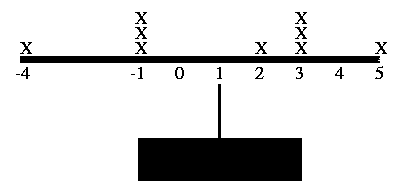DefinitionsAVERAGEEvery one knows how to compute the AVE. Given a list of numbers, the AVE is just the sum of the numbers divided by how many numbers there are in the list.EXAMPLEConsider the list |
> L := 3,2,-1,-4,5:
| the AVE of the list L is, |
> AVE := (3+2+(-1)+(-4)+5)/5;
AVE := 1
The AVE can be thought as the point of balance for the list So the lists L1,L2 and L3 all have the same AVE = 1. |
> L1 := 3,3,3,2,-1,-1,-1,-4,5:
> L2 := 3,2,-1,-4,5,1,1,1,1,1:
> L3 := 3,2,-1,4,5,-2,0,2,4:
This is because the extra points do not change the balance point.
For example L1, looks like:
 The extra points added to L2 are all on top of the AVE=1 so clearly the list stays balanced after the extra 1,1,1,1,1. Can you see why the AVE of L3 is still 1? Properties of the AVEWhat happens to the AVE if we add the same number to each entry of a list?EXAMPLEWhat is the NewAVE of the list obtained by adding 3 to each of the entries of the list L above? |
> Answer:
| The NewL is |
> NewL := 3+3, 2+3, -1+3, -4+3, 5+3;
NewL := 6, 5, 2, -1, 8> NewAVE := (6+5+2-1+8)/5;
NewAVE := 4
Notice that NewAVE = AVE + 3this is always the case. The reason is obvious from the fact that the average is the balance point of a list of numbers. For, adding a number (3 in the example) to each entry of a list produces a new list which is shifted to the right by that number. Thus, the AVE must also be shifted to the right by the same number to produce the NewAVE.What happens to the AVE if we multiply each entry by the same number c, say?EXAMPLEFind the NewAVe for NewList obtained by multiplying each entry of L by c. |
> Answer:
> NewList := c*3, c*2, c*(-1), c*(-4), c*5;
NewList := 3 c, 2 c, -c, -4 c, 5 c> NewAVE := (3*c+2*c-c-4*c+5*c)/5;
NewAVE := c
see what happens? The c can be factorized out of the sum and we always haveNewAVE = c * OldAVEThere is a simple reason for this. Multiplying each entry by a number can be thought as a change of units (e.g. the original entries where in centimeters and now you want the same list in inches). Hence the two list are the same list in two different systems of units and therefore the two averages MUST BE the same AVE but in the two systems of units i.e. If the original AVE was the balance point in centimeters then the NewAVE must be the same but in inches. |